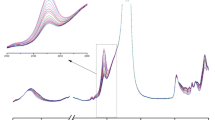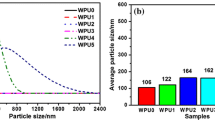Abstract
A composition-dependent microphase separation of segmented poly(urethane urea)s (PUUs), based on a mixture of two hydrophobic (polycaprolactone) and hydrophilic (polyethylene glycol) polyols, is investigated. Synthesis of PUUs was carried out through the reaction of in situ generated AB-type macromonomers, prepared from the reaction of NCO-terminated urethane prepolymers, with benzoic acid in dimethyl sulfoxide as solvent/reagent at 40–80 °C. The segmented PUUs were characterized by different methods including FTIR and NMR spectroscopies, gel permeation chromatography, differential scanning calorimetry and dynamic mechanical analysis. Microphase separation in the synthesized PUUs was monitored using atomic force microscopy (AFM) to find a better insight into structure–property relationship of PUUs consisting of mixed polyols. Thermal analysis of the polymers revealed that by introducing poly(ethylene glycol) (PEG) in PUU backbone, a well-defined glass transition was obtained. The results of AFM showed that PCL-based poly(urethane urea) has a morphology in which hard segment domains were homogeneously distributed in the soft segment matrix. In the samples based on PCL/PEG, the hard segment domains aggregates were connected to each other and were inhomogeneously distributed in the matrix. Comparison of the overall data revealed that the differences in soft segment compositions had a marked effect on the molecular structure and the mechanical properties of PUUs.








Similar content being viewed by others
References
Wu L, You B, Li D, Qian F (2000) The in vitro and in vivo stability of poly(urethane urea)s as biomedical materials. Polym Degrad Stab 70:65–69
Hong Y, Guan J, Fujimoto KL, Hashizume L, Pelinescu AL, Wagner WR (2010) Tailoring the degradation kinetics of poly(ester carbonate urethane)urea thermoplastic elastomers for tissue engineering scaffolds. Biomaterials 31:4249–4258
Wang F, Li Z, Lannutti JL, Wagner WR, Guan J (2009) Synthesis, characterization and surface modification of low moduli poly(ether carbonate urethane)ureas for soft tissue engineering. Acta Biomater 5:2901–2912
Hood MA, Wang B, Sands JM, La Scala JJ, Beyer FL, Li CY (2010) Morphology control of segmented polyurethanes by crystallization of hard and soft segments. Polymer 51:2191–2198
Wang CB, Cooper SL (1983) Morphology and properties of segmented polyether polyurethane ureas. Macromolecules 16:775–786
Christenson EM, Anderson JM, Hiltner A, Baer E (2005) Relationship between nano-scale deformation processes and elastic behavior of polyurethane elastomers. Polymer 46:11744–11754
Bagdi K, Molnár K, Sajó I, Pukánszky B (2011) Specific interactions, structure and properties in segmented polyurethane elastomers. Express Polym Lett 5:417–427
Shokrollahi P, Mirzadeh H, Huck WTS, Scherman QA (2010) Effect of self-complementary motifs on phase compatibility and material properties in blends of supramolecular polymers. Polymer 51:6303–6312
Garrett JT, Xu R, Cho J, Runt J (2003) Phase separation of diamine chain-extended poly(urethane) copolymers: fTIR spectroscopy and phase transitions. Polymer 44:2711–2719
Wisse E, Spiering AJH, van Leeuwen ENM, Renken RAE, Dankers PYW, Brouwer LA, van Luyn MJA, Harmsen MC, Sommerdijk NAJM, Meijer EW (2006) Molecular recognition in poly(ε-caprolactone)-based thermoplastic elastomers. Biomacromolecules 7:3385–3395
Pongkitwitoon S, Herna´ndez R, Weksler J, Padsalgikar A, Choi T, Runt J (2009) Temperature dependent micro-phase mixing of model polyurethanes with different inter-segment compatibilities. Polymer 50:6305–6311
Huang SL, Chao MS, Ruaan RC, Lai JY (2000) Micro-phase separated structure and protein adsorption of polyurethanes with butadiene soft segment. Eur Polym J 36:285–294
Pergal MV, Džunuzovic JV, Poreba R, Ostojic S, Radulovic A, Špírková M (2013) Microstructure and properties of poly(urethane-siloxane)s based on hyperbranched polyester of the fourth pseudo generation. Prog Org Coat 76:743–749
O’Sickey MJ, Lawrey BD, Wilks JL (2002) Structure–property relationships of poly(urethane urea)s with ultra-low monol content poly(propylene glycol) soft segments. I. Influence of soft segment molecular weight and hard segment content. J Appl Polym Sci 84:229–243
Eceiza A, Larranaga M, de la Caba K, Kortaberria G, Marieta C, Corcuera MA, Mondragon I (2008) Structure–property relationships of thermoplastic polyurethane elastomers based on polycarbonate diols. J Appl Polym Sci 108:3092–3103
Gisselfalt K, Helgee B (2003) Effect of soft segment length and chain extender structure on phase separation and morphology in poly(urethane urea)s. Macromol Mater Eng 288:265–271
Sheth JP, Unal S, Yilgor E, Yilgor I, Beyer FL, Long TE, Wilkes GL (2005) A comparative study of the structure–property behavior of highly branched segmented poly(urethane urea) copolymers and their linear analogs. Polymer 46:10180–10190
Dasa S, Cox DF, Wilkes GL, Klinedinst DB, Yilgor I, Yilgor E, Beyerd FL (2007) Effect of symmetry and H-bond strength of hard segments on the structure property relationships of segmented, nonchain extended polyurethanes and polyureas. J Macromol Sci B 46:853–875
Shokrolahi F, Yeganeh H, Mirzadeh H (2011) Simple and versatile method for the one-pot synthesis of segmented poly(urethane urea)s via in situ-formed AB-type macromonomers. Polym Int 60:620–629
Guelcher SA (2008) Biodegradable polyurethanes: synthesis and applications in regenerative medicine. Tissue Eng Part B 14:3–17
Gorna K, Gogolewski S (2002) Biodegradable polyurethanes for implants. II. In vitro degradation and calcification of materials from poly(ε-caprolactone)-poly(ethylene oxide) diols and various chain extenders. J Miomed Mater Res 60:592–606
Guan J, Sacks MS, Beckman EJ, Wagner WR (2004) Biodegradable poly(ether ester urethane)urea elastomers based on poly(ether ester) triblock copolymers and putrescine: synthesis, characterization and cytocompatibility. Biomaterials 25:85–96
Luo N, Wang DN, Ying SK (1996) Hydrogen bonding between urethane and urea: band assignment for the carbonyl region of FTIR spectrum. Polymer 37:3045–3047
Scerba MT, DeBlase AF, Bloom S, Dudding T, Johnson MA, Lectka T (2012) Characterization of highly unusual NH+-O hydrogen bonding to ester ether oxygen atoms through spectroscopic and computational studies. J Phys Chem A 116:3556–3560
Sheth JP, Klinedinst DB, Wilkes GL, Yilgor I, Yilgor E (2005) Role of chain symmetry and hydrogen bonding in segmented copolymers with monodisperse hard segments. Polymer 46:7317–7322
Author information
Authors and Affiliations
Corresponding author
Rights and permissions
About this article
Cite this article
Shokrolahi, F., Yeganeh, H. Soft segment composition and its influence on phase-separated morphology of PCL/PEG-based poly(urethane urea)s. Iran Polym J 23, 505–512 (2014). https://doi.org/10.1007/s13726-014-0245-8
Received:
Accepted:
Published:
Issue Date:
DOI: https://doi.org/10.1007/s13726-014-0245-8




